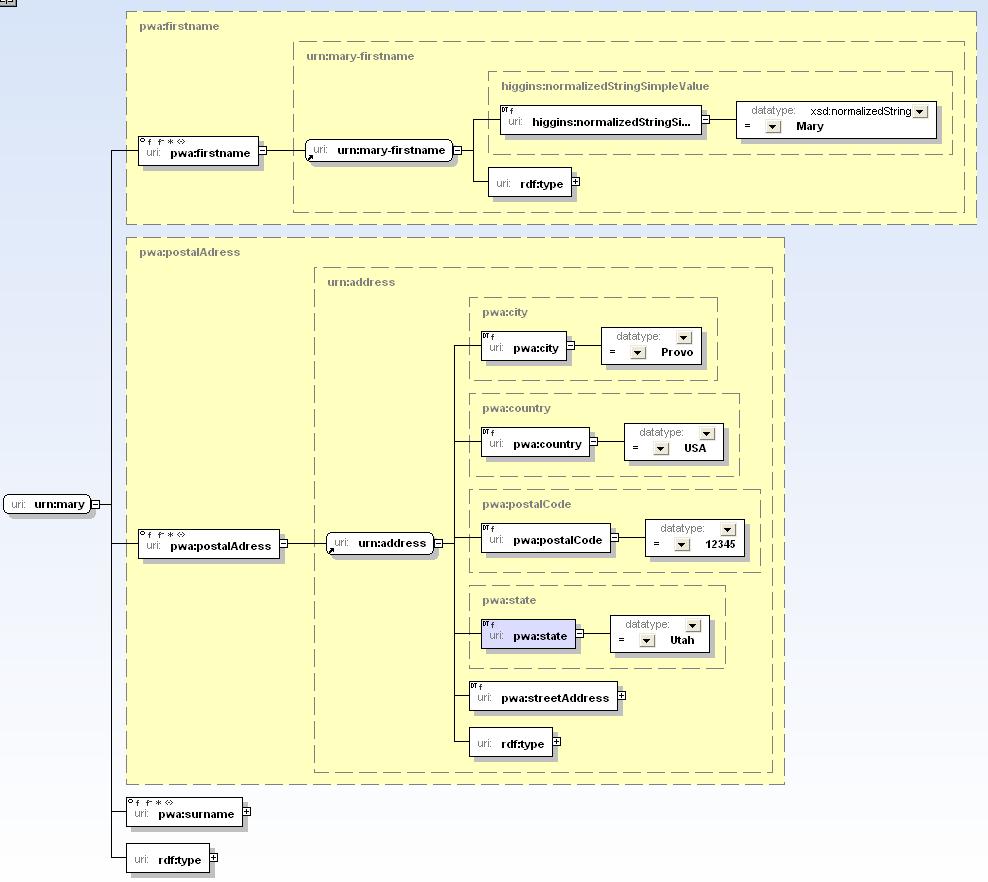Notice: this Wiki will be going read only early in 2024 and edits will no longer be possible. Please see: https://gitlab.eclipse.org/eclipsefdn/helpdesk/-/wikis/Wiki-shutdown-plan for the plan.
Person-with-address Example Context Ontology
Let's imagine a Context whose domain involved things (or more precisely Digital Subjects) called Persons. Each Person has a surname, firstname and a postal address. And let's say that this postal address is something that could be described in XML schema as:
<xsd:complexType name="postalAddress"> <xsd:sequence> <xsd:element name="streetAddress" type="xsd:string" /> <xsd:element name="city" type="xsd:string" /> <xsd:element name="state" type="xsd:string" /> <xsd:element name="postalCode" type="xsd:integer" minOccurs="0" /> <xsd:element name="country" type="xsd:string" minOccurs="0" /> </xsd:sequence> </xsd:complexType>
Note: For the sake of simplicity, we are going to side-step best practice and not model what in IdAS is called the "source" of these attributes. As far as we are concerned these attributes came out of thin air.
For this example we've created: http://www.eclipse.org/higgins/ontologies/2006/person-with-address.owl The first part of the file is the ontology, the last part is the instance data.
Context Providers need to do is declare the ontology that will provide the language in which to describe instances of Persons along with their associated simple attributes (surname and first name) and compound attributes (postal address). In this case the provider a person-with-address.owl ontology.
You'll notice that like all Context ontologies, it includes near the top an "import" statement that imports the required base higgins.owl ontology.
Contents
Context Instance Data
Context Providers are also responsible for being able to export the Contexts they manage. Here is an example of an export to RDF of a Context that contains one Person (Mary) and conforms to the person-with-address ontology.
<pwa:PostalAddress rdf:about="urn:address"> <pwa:city>Provo</pwa:city> <pwa:country>USA</pwa:country> <pwa:postalCode>12345</pwa:postalCode> <pwa:state>Utah</pwa:state> <pwa:streetAddress>123 Main St.</pwa:streetAddress> </pwa:PostalAddress> <pwa:Person rdf:about="urn:mary"> <pwa:postalAdress rdf:resource="urn:address"/> <pwa:firstname rdf:resource="urn:mary-firstname"/> <pwa:surname rdf:resource="urn:mary-surname"/> </pwa:Person> <higgins:NormalizedStringSimpleAttribute rdf:about="urn:mary-firstname"> <higgins:normalizedStringSimpleValue rdf:datatype="&xsd;normalizedString">Mary </higgins:normalizedStringSimpleValue> </higgins:NormalizedStringSimpleAttribute> <higgins:NormalizedStringSimpleAttribute rdf:about="urn:mary-surname"> <higgins:normalizedStringSimpleValue rdf:datatype="&xsd;normalizedString">Ruddy </higgins:normalizedStringSimpleValue> </higgins:NormalizedStringSimpleAttribute>
Here is a graphical view of the instance data: 
Relationship to IdAS API
Let's look at Mary and her first name from the point of view (POV) of both the ontology/schema and IdAS API:
Mary and her name
- schema POV: is a resource of type pwa:Person (a subclass of higgins:DigitalSubject)
- IdAS POV: is an IDigitalSubject. This would be returned, e.g. from a call to someContext.getSubject("urn:mary")
pwa:firstname
- schema POV: is an RDF property (pwa:firstname) whose range is urn:mary-firstname
- IdAS POV: is an IAttribute. From the IDigitalSubject retreived above, one may call someDS.getAttribute(new URI("pwa:firstname")); which should return an instance of IAttribute. Calling someAttribute.getType on that IAttribute instance will return the URI "pwa:firstname".
- schema POV: is a resource of type higgins:NormalizedStringSimpleAttribute
- IdAS POV: is an IPropertyValue sub-interface. Given the IAttribute instance found above, we could call someAttribute.getValue() and this would return an IPropertyValue instance. Calling somePropertyValue.getType() would return "xsd:string". Calling somePropertyValue.getData() would return a Java String containing the value "Mary".
Mary and her address
pwa:address
- schema POV: is an RDF property (pwa:address) whose range is urn:address
- IdAS POV: is an IAttribute. From the IDigitalSubject retreived above, one may call someDS.getAttribute(new URI("pwa:postalAddress")); which should return an instance of IAttribute. Calling someAttribute.getType() on that IAttribute instance will return the URI "pwa:postalAddress".
urn-address
- schema POV: is a resource of type pwa:PostalAddress
- IdAS POV: is an IPropertyValue sub-interface. Given the IAttribute instance found above, we could call someAttribute.getValue() and this would return an IPropertyValue instance. Calling somePropertyValue.getType() would return "pwa:PostalAddress". Calling someProperty.isSimple() would return false, so we know this object has sub-parts.
pwa:city
- schema POV: is an RDF property (pwa:city) whose range is an xsd:string
- IdAS POV: is an IProperty. This property may be gotten by calling getProperty(new URI("pwa:city")) on the 'somePropertyValue' retreieved above.
